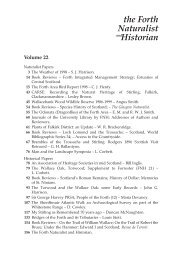fnh journal vol 24 - Forth Naturalist and Historian - University of Stirling
fnh journal vol 24 - Forth Naturalist and Historian - University of Stirling
fnh journal vol 24 - Forth Naturalist and Historian - University of Stirling
You also want an ePaper? Increase the reach of your titles
YUMPU automatically turns print PDFs into web optimized ePapers that Google loves.
14 S. J. Harrison<br />
• October 29th/30th: Heavy rain over much <strong>of</strong> Scotl<strong>and</strong> which fell as snow in<br />
some areas.<br />
• December 27th: Heavy snowfall which closed some airports. 20 cm <strong>of</strong> snow<br />
lying in Glasgow.<br />
Bridge <strong>of</strong> Allan Flood Diary 2000<br />
The Allan overtopped its banks near Bridge <strong>of</strong> Allan on the following dates:<br />
1st February, 27th February, 11th September, 9th October, 29th October.<br />
Scottish Snowfall Changes Project<br />
Maps have been produced which estimate the number <strong>of</strong> days with snow<br />
lying which may be expected in the 2020s, 2050s <strong>and</strong> the 2080s. These have<br />
been based on climatic analogues. The final report on the research, which was<br />
commissioned by the Scottish Executive, was published in May 2001.<br />
Changes in the number <strong>of</strong> days on which snow is lying on the ground<br />
during the winter months as a result <strong>of</strong> large scale change in climate has<br />
implications for both the economy <strong>and</strong> the environment <strong>of</strong> Scotl<strong>and</strong>. The<br />
greatest effects will be felt in the winter tourism sector where opportunities for<br />
skiing <strong>and</strong> ice climbing are likely to be greatly reduced. There are further<br />
knock-on effects for related activities such as accommodation, catering,<br />
retailing <strong>and</strong> local employment. However, with some adaptation it is likely that<br />
Scotl<strong>and</strong> can continue to <strong>of</strong>fer opportunities to engage in these activities. The<br />
clearing <strong>of</strong> snow from the roads should become less <strong>of</strong> a problem, but the<br />
variable nature <strong>of</strong> the Scottish climate will always make it necessary to remain<br />
prepared for the occasionally heavy snowfall. Greater access to the l<strong>and</strong> during<br />
the winter will mean that operations such as logging could continue but there<br />
will be a temptation for greater numbers <strong>of</strong> walkers to get into the hills. This<br />
may cause more trampling damage <strong>and</strong> could also disturb wildlife. Floods may<br />
become more frequent during the winter months but less frequent in spring,<br />
which will affect water-resource management, hydro-electric power<br />
generation <strong>and</strong> river habitats.<br />
Reference<br />
Harrison S.J., Winterbottom S.J. <strong>and</strong> Johnson R.C. (2001) Climate Change <strong>and</strong> Changing<br />
Snowfall Patterns in Scotl<strong>and</strong> Scottish Executive Environment Group Research Findings<br />
No.14. Edinburgh. The Stationery Office.<br />
This report is based on the Annual Climatological Bulletin <strong>of</strong> the <strong>University</strong> <strong>of</strong> <strong>Stirling</strong>,<br />
copies <strong>of</strong> which may be obtained from the author, S.J. Harrison, at the Department <strong>of</strong><br />
Environmental Science, <strong>University</strong> <strong>of</strong> <strong>Stirling</strong>, <strong>Stirling</strong> FK9 4LA.



